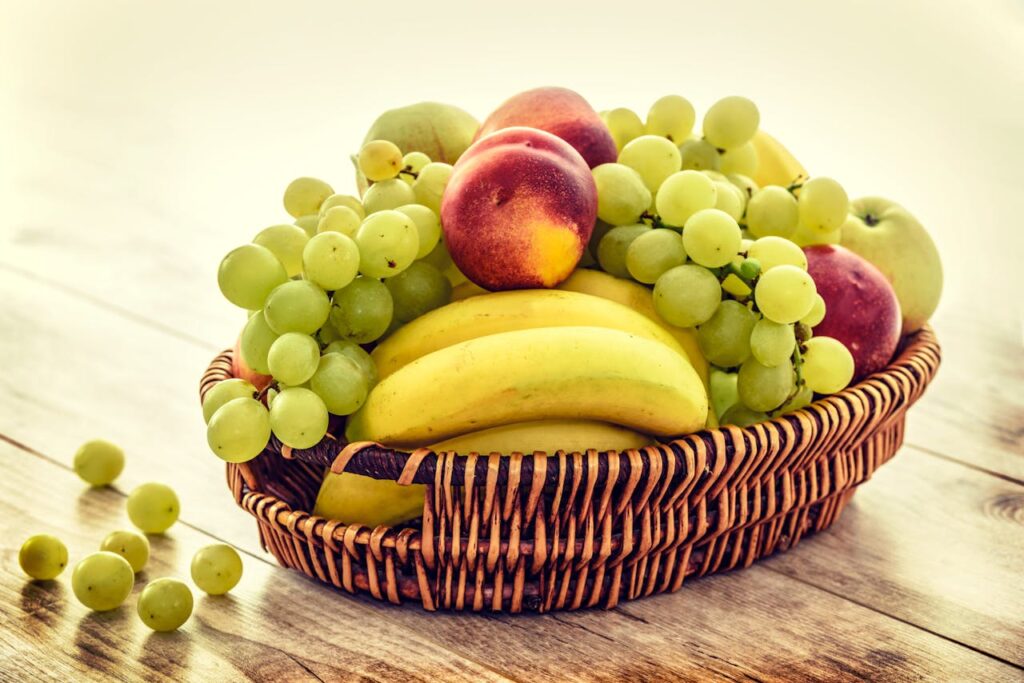
Explore & Play
Discover interesting topics and solve the accompanying crossword puzzle.
Fruit crossword | Unique Fruits from Around the World
Table of Contents
Looking for a fun way to learn about fruits? Start with our fruit crossword to test your knowledge and see how many varieties you already know. If you’re not quite familiar with the topic, feel free to dive into the article first, and then come back to the fruit crossword to challenge yourself with all the new information you’ve discovered!
Ftuit Crossword
You can either fill in the crossword puzzle directly on this page or click the button in the bottom right corner to print it for free.

Around the World in 50 Fruits: Discovering Global Flavors
Fruits are not only nature’s candy but also a cultural treasure trove that reflects the diversity of our world’s landscapes and traditions. From the lush jungles of Southeast Asia to the sunny orchards of North America, fruits provide a taste of place, a touch of tradition, and a bounty of health benefits. This article will take you on a global journey, introducing 50 different fruits—some you may know well and others you may just be meeting for the first time. As you read, you’ll discover their unique flavors, uses, and cultural significance. And for a bit of fun, don’t forget to test your newfound knowledge with our fruit-themed crossword puzzle!
Section 1: Fruits of the Americas – From Orchards to Tropics
The Americas, stretching from the temperate zones of North America to the lush rainforests of South America, offer a diverse array of fruits that reflect the continent’s varied climates and cultures. From the classic favorites of the northern orchards to the exotic treasures of the southern tropics, fruits play a significant role in the culinary traditions and daily lives of people across the Americas. Let’s delve into some of the standout fruits from each region.
1.1 North America’s Classics
Apples:
Apples are a quintessential fruit of North America, known for their versatility and wide range of varieties. Whether you prefer a crisp Granny Smith, a sweet Fuji, or a tart Honeycrisp, apples are a staple in many households. They are celebrated for their use in traditional dishes such as apple pie, a comforting dessert that evokes the essence of American home cooking. Apples are also enjoyed fresh, in salads, or pressed into apple cider, making them a year-round favorite. Beyond their taste, apples are packed with dietary fiber and antioxidants, contributing to their status as a nutritious and beloved fruit.
Blueberries and Cranberries:
Both blueberries and cranberries are native to North America and have achieved superfood status due to their impressive health benefits. Blueberries, often referred to as “nature’s candy,” are rich in antioxidants called anthocyanins, which are linked to improved cognitive function and heart health. They are enjoyed fresh, in smoothies, baked goods, or as a topping for yogurt and cereals. Cranberries, known for their tartness, are commonly used in sauces, juices, and dried snacks. Their high levels of proanthocyanidins are associated with urinary tract health and immune support. Together, these berries offer a powerhouse of nutrition and flavor.
Cherries:
Cherries, with their vibrant red color and delightful tart-sweet flavor, are another North American favorite. They are enjoyed fresh, in pies, tarts, or as a garnish for cocktails. Cherries are also used in preserves and jams, capturing their seasonal flavor for enjoyment throughout the year. Rich in antioxidants and anti-inflammatory compounds, cherries are not only delicious but also provide health benefits such as improved sleep quality and reduced muscle soreness.
1.2 Tropical Treasures of South America
Acai:
Acai berries, with their deep purple hue, are a nutritional powerhouse from South America’s Amazon rainforest. Known for their high antioxidant content, acai berries are often blended into smoothies and bowls, where they are combined with other fruits and superfoods to create nutrient-dense meals. The berries have a rich, earthy flavor that pairs well with a variety of ingredients, making them a popular choice for health-conscious eaters. Acai’s antioxidant properties are believed to support heart health, improve skin appearance, and boost overall energy levels.
Papaya:
Papayas, with their sweet, orange flesh and tropical aroma, are a staple breakfast fruit across South America. They are often enjoyed sliced with a squeeze of lime or blended into refreshing smoothies. Papayas are also used in savory dishes, such as salads and salsas, where their natural sweetness complements spicy and tangy flavors. Rich in vitamins A and C, as well as digestive enzymes like papain, papayas aid in digestion and support immune function.
Passionfruit:
Passionfruit, with its unique, aromatic pulp and crunchy seeds, is a popular fruit in South American cuisine. Its tart-sweet flavor makes it a favorite ingredient in desserts, such as mousses and tarts, as well as in beverages like juices and cocktails. The fruit’s vibrant, exotic flavor adds a tropical twist to a variety of dishes. Passionfruit is also valued for its health benefits, including high levels of vitamin C, antioxidants, and dietary fiber, which contribute to overall wellness.
Guava:
Guava is a versatile fruit found throughout South America, known for its range of flavors from sweet to tangy. It is used in many traditional dishes, such as Brazil’s beloved guava paste, which is a sweet and chewy treat enjoyed as a snack or dessert. Guava’s unique flavor profile makes it a popular choice for juices, jams, and salsas. The fruit is rich in vitamin C, dietary fiber, and antioxidants, supporting immune health and digestion. Fresh guava can be eaten on its own or incorporated into a variety of recipes to add a tropical flair.
Section 2: Asian Delicacies – A World of Sweetness and Spice
Asia, with its diverse climates and rich cultural heritage, offers a spectacular array of fruits that range from tropical delights to nuanced regional specialties. The fruits of Asia are not only integral to the local cuisine but also add unique flavors and textures to dishes around the world. Let’s delve into the bountiful harvest of Southeast Asia and the distinctive offerings of East Asia.
2.1 Southeast Asia’s Bountiful Harvest
Mango:
Mango, often hailed as the “king of fruits” in Southeast Asia, is celebrated for its juicy, aromatic flesh and vibrant flavor. This tropical fruit is a staple in many Southeast Asian countries, where it is enjoyed in a variety of ways. Fresh mango slices are a refreshing treat on their own or can be blended into smoothies for a tropical twist. Mango is also used in traditional dishes such as Thai mango sticky rice, a sweet and savory dessert made with glutinous rice and coconut milk. Additionally, mango chutneys and salsas add a fruity kick to savory dishes, enhancing their complexity with a touch of sweetness.
Pineapple:
Pineapple, with its sharp, tangy sweetness, is a versatile fruit that plays a prominent role in Southeast Asian cuisine. Its bright, tropical flavor complements a range of dishes, from Thai curries to sweet and sour sauces. Pineapple is also used in fruit salads, where its juiciness adds a refreshing contrast to other ingredients. The fruit’s natural enzymes make it a great addition to marinades, where it tenderizes meat and adds a sweet, acidic note. Pineapple’s adaptability and vibrant taste make it a favorite in both traditional and contemporary recipes.
Durian:
Durian is known as the “king of fruits” in many parts of Southeast Asia, though it is famously divisive due to its strong aroma. This fruit has a creamy texture and a complex flavor profile that combines sweetness with a hint of savory notes. For those who appreciate its unique taste, durian is a delicacy enjoyed in a variety of forms, from fresh fruit to durian ice cream and pastries. In some cultures, durian is used in savory dishes, adding an unusual depth of flavor. Its distinctive smell and rich, custard-like texture make durian a memorable and often polarizing fruit experience.
Rambutan:
Rambutan, with its spiky red skin and juicy, translucent flesh, is a visually striking fruit that offers a sweet, slightly tangy flavor. The fruit is often enjoyed fresh, peeled to reveal the juicy, grape-like interior. Rambutan can also be used in fruit salads, desserts, and beverages, where its unique texture and flavor add an exotic touch. Rich in vitamins and antioxidants, rambutan provides a refreshing and nutritious option for fruit enthusiasts.
Lychee:
Lychee, with its delicate, floral aroma and sweet, juicy flesh, is a beloved fruit in Southeast Asia. Its translucent, pearly interior offers a burst of sweetness that is both refreshing and aromatic. Lychee is commonly enjoyed fresh, in fruit salads, or as part of desserts such as lychee sorbet. The fruit’s subtle flavor also pairs well with both sweet and savory dishes, making it a versatile ingredient in Asian cuisine. Lychee is valued for its hydrating properties and high vitamin C content.
Jackfruit:
Jackfruit is an incredibly versatile fruit that can be used in both savory and sweet dishes. Its large, spiky exterior hides a bright yellow, fibrous flesh that has a sweet, tropical flavor when ripe. Jackfruit can be eaten fresh or used in a variety of recipes, from jackfruit curries to vegan pulled “pork,” where its texture mimics that of shredded meat. Unripe jackfruit, with its neutral flavor, is often used in savory dishes and stir-fries. The fruit’s adaptability and substantial texture make it a popular choice in both traditional and modern cooking.
2.2 East Asia’s Unique Offerings
Persimmons:
Persimmons are a cherished autumn fruit in Japan and Korea, appreciated for their sweet, honey-like flavor and smooth texture. They can be enjoyed fresh, with their vibrant orange skin adding a pop of color to salads and desserts. Dried persimmons, known as “fuyu” or “kaki,” offer a chewy, concentrated sweetness that is enjoyed as a snack or used in traditional sweets. Persimmons are also used in Japanese-style puddings and baked goods, where their subtle flavor enhances a variety of treats.
Kiwi:
Originally from China, kiwi has become a global favorite for its tangy flavor and high vitamin C content. This small, brown fruit with its vibrant green flesh and tiny black seeds offers a refreshing and tart taste. Kiwi is often enjoyed fresh, sliced into salads, or blended into smoothies. Its unique flavor also pairs well with other fruits, making it a popular choice for fruit salads and desserts. The high levels of vitamin C and antioxidants in kiwi contribute to its status as a nutritious and flavorful fruit.
Asian Pears:
Asian pears, known for their crisp texture and delicate sweetness, are a staple in East Asian cuisine. These round, apple-like fruits are often served fresh, sliced into salads, or used in desserts. Asian pears are valued for their juicy, crunchy texture and subtle, refreshing flavor. They can also be poached or used in savory dishes, where their sweetness adds complexity to the flavors. The fruit’s crispness and unique taste make it a versatile and beloved addition to East Asian culinary traditions.
Plums:
Plums, with their tart skin and sweet, juicy flesh, are enjoyed throughout East Asia in a variety of culinary applications. They are commonly used in sauces and jams, where their tangy flavor adds depth to both sweet and savory dishes. In traditional sweets, plums are used to create flavorful fillings and toppings. Their versatility and balanced flavor profile make them a popular choice in both contemporary and traditional recipes. Plums are also appreciated for their high vitamin C and antioxidant content, contributing to their nutritional benefits.
Section 3: European Orchards – From Mediterranean Groves to Nordic Forests
Europe’s diverse climate zones and rich agricultural traditions offer a delightful array of fruits, each with its own unique characteristics and culinary uses. From the sun-drenched groves of the Mediterranean to the cooler climates of Northern Europe, the continent’s fruits reflect its varied landscapes and cultural practices. Let’s explore the fruits that define these regions, celebrating their flavors and contributions to European cuisine.
3.1 The Mediterranean’s Citrus and Stone Fruits
Oranges, Lemons, and Limes:
The Mediterranean region is renowned for its citrus fruits, which thrive in its sunny, temperate climate. Oranges, with their bright, tangy sweetness, are used in a wide variety of dishes, from fresh juices to salads. Lemon zest and juice add a zesty kick to both savory and sweet recipes, while limes provide a refreshing tartness that enhances everything from dressings to desserts. Citrus fruits are also key ingredients in Mediterranean cuisine, featured in dishes like Greek lemon chicken and Spanish paella, where their vibrant flavors bring depth and freshness to the meals.
Grapefruit:
Grapefruit, known for its tangy and slightly bitter flavor, is a popular choice for breakfast across the Mediterranean. It can be enjoyed fresh, often with a sprinkle of sugar or a drizzle of honey, or used in fruit salads to add a touch of acidity. Grapefruit is also used in a variety of Mediterranean cocktails and beverages, where its bright flavor complements other ingredients. Beyond its culinary uses, grapefruit is valued for its high vitamin C content and antioxidant properties.
Figs:
Figs are a beloved fruit in Mediterranean cuisine, known for their honey-like sweetness and chewy texture. They are used in a variety of sweet and savory dishes, from fig jams and pastries to salads and roasted meats. Figs are often paired with cheese and nuts, creating a delightful contrast of flavors. Their natural sweetness and rich texture make them a versatile ingredient in both traditional and modern Mediterranean recipes.
Nectarines:
Nectarines, with their juicy, sweet flesh and smooth skin, are a summer favorite in the Mediterranean region. They are enjoyed fresh, sliced into salads, or used in desserts like tarts and cobblers. Nectarines can also be grilled or roasted, enhancing their natural sweetness and creating a caramelized flavor. Their vibrant color and juicy texture make them a refreshing addition to a variety of dishes.
Pomegranates:
Pomegranates, with their jewel-like seeds and tart, sweet flavor, are a staple in Mediterranean cooking. The seeds, or arils, are used in salads, desserts, and sauces, adding a burst of color and a delightful crunch. Pomegranate juice is also a popular ingredient in Mediterranean beverages and dressings. The fruit’s antioxidant-rich seeds are celebrated for their health benefits, including their potential to improve heart health and reduce inflammation.
3.2 Northern Europe’s Berries and Beyond
Blackberries:
Blackberries, with their deep purple hue and sweet-tart flavor, thrive in the cooler climates of Northern Europe. They are commonly used in jams, pies, and crumbles, where their rich flavor and juicy texture shine. Blackberries can also be enjoyed fresh, added to yogurt or cereal, or incorporated into savory dishes like sauces and glazes. Their high levels of vitamins and antioxidants contribute to their popularity as a healthy and flavorful fruit.
Raspberries:
Raspberries are another favorite in Northern European orchards, known for their delicate texture and sweet, tangy taste. They are often used in desserts such as tarts, mousses, and sauces, as well as in jams and preserves. Raspberries can also be added to salads and smoothies, where their bright flavor complements other ingredients. Their high vitamin C and fiber content make them a nutritious choice for a variety of dishes.
Gooseberries:
Gooseberries, with their tart flavor and firm texture, are a traditional fruit in Northern Europe. They are used in a variety of recipes, from gooseberry fool and crumbles to savory sauces and chutneys. Gooseberries can be enjoyed fresh or cooked, and their tangy flavor pairs well with sweet and savory ingredients. They are also valued for their high vitamin C content and antioxidants, which contribute to their health benefits.
Strawberries:
Strawberries, with their sweet, juicy flavor and vibrant red color, are a beloved fruit in Northern Europe. They are enjoyed fresh, in desserts like strawberry shortcake and pavlova, or used to make jams and preserves. Strawberries can also be added to salads, smoothies, and beverages, where their natural sweetness enhances a variety of dishes. Their high levels of vitamin C and antioxidants make them a popular and nutritious choice.
Mulberries:
Mulberries, though less common, are cherished for their sweet-tart flavor and unique texture. They are used in various recipes, from compotes and jams to teas and baked goods. Mulberries can be enjoyed fresh or dried, and their flavor adds depth to both sweet and savory dishes. The fruit’s rich nutritional profile, including vitamins and minerals, contributes to its appeal as a healthful and flavorful ingredient.
Section 4: Middle Eastern and African Gems – Fruits of the Desert and Savannah
The arid deserts of the Middle East and the expansive savannahs of Africa offer a rich variety of fruits that have adapted to their challenging climates. These fruits not only provide essential nutrients but also add unique flavors and textures to the regional cuisines. From the sweet and energizing dates of the Middle East to the exotic fruits of Africa, each fruit tells a story of survival and adaptation in diverse environments.
4.1 Middle Eastern Delicacies
Dates:
Dates are often referred to as the ‘bread of the desert’ due to their historical significance and nutritional value. This staple fruit is a major source of energy and is deeply embedded in Middle Eastern culture. Dates are enjoyed fresh or dried, and their natural sweetness makes them a popular ingredient in both sweet and savory dishes. They are used in traditional recipes such as date-studded pastries, date syrup, and even savory stews, where their rich flavor enhances the dish. Dates are also a key component in many Middle Eastern sweets, including ma’amoul, a filled pastry that combines dates with nuts and spices.
Figs:
Figs have been a cherished fruit in the Middle East since ancient times, prized for their natural sweetness and versatility. Fresh figs, with their tender skin and honey-like flavor, are enjoyed on their own or added to salads, cheese plates, and desserts. Dried figs, with their concentrated sweetness, are used in a variety of dishes, including traditional Middle Eastern stews and pastries. Figs are also blended into jams and spreads, where their rich flavor complements other ingredients. Their historical significance and culinary uses make figs a symbol of the region’s agricultural heritage.
Pomegranates:
Pomegranates, with their jewel-like seeds, are a symbol of prosperity and abundance in Middle Eastern cultures. The seeds, or arils, are used in a range of dishes, from salads and sauces to desserts and beverages. Pomegranate juice is a popular ingredient in Middle Eastern cuisine, used to add a tart, fruity flavor to dishes like kebabs and rice. The fruit’s vibrant color and refreshing taste make it a versatile component in many recipes, and its antioxidant-rich seeds contribute to its status as a superfood.
Apricots:
Apricots, with their aromatic and tangy flavor, are widely used in Middle Eastern cuisine. They are enjoyed fresh or dried and are incorporated into a variety of dishes, including jams, stews, and traditional sweets. In many Middle Eastern countries, apricots are used to make a popular dessert known as apricot jam, which is often served with bread or pastries. The fruit’s sweet and slightly tart flavor adds a distinctive taste to both savory and sweet recipes, making it a staple ingredient in regional cooking.
Quinces:
Quinces, known for their aromatic and tangy flavor, are used in a variety of Middle Eastern dishes. The fruit is often cooked to soften its texture and enhance its natural sweetness. Quinces are used to make jams, preserves, and traditional sweets such as Turkish delight, where their unique flavor is highlighted. They are also added to stews and braises, where their slightly tangy taste complements other ingredients. Quinces’ aromatic qualities and versatility make them a valuable addition to Middle Eastern cuisine.
4.2 Africa’s Exotic Fruits
Soursop:
Soursop, also known as graviola, is a tropical fruit native to West Africa and other tropical regions. With its creamy, custard-like flesh and distinctive flavor, soursop is enjoyed fresh or used in beverages and desserts. The fruit’s unique taste combines citrus and pineapple notes with a hint of vanilla, making it a popular choice for smoothies, juices, and sorbets. Soursop is also believed to have potential health benefits, including anti-inflammatory and immune-boosting properties, adding to its appeal as a nutritious and flavorful fruit.
Coconut:
Coconut is one of the most versatile fruits, providing not only refreshing water and creamy milk but also a rich, fatty flesh that is used in a variety of dishes. In Africa, coconut is a staple ingredient in many cuisines, from curries and stews to desserts and snacks. The fruit’s water is enjoyed as a hydrating beverage, while the milk is used to add richness and flavor to dishes. The flesh can be grated or shredded and used in baking, cooking, or as a topping for various recipes. Coconut’s versatility and nutritional value make it a beloved ingredient in African cuisine.
Papaya:
Papaya, with its sweet, fragrant flesh, is popular across Africa for its refreshing taste and nutritional benefits. The fruit is often enjoyed fresh, added to fruit salads, or blended into smoothies. Papaya is also used in traditional African dishes, where its sweet flavor complements savory ingredients. The fruit’s high vitamin C content and digestive enzymes, such as papain, contribute to its health benefits, including improved digestion and immune support. Papaya’s vibrant color and sweet taste make it a favorite addition to a variety of dishes.
Custard Apple:
Custard apple, also known as cherimoya, is a tropical fruit with a creamy, custard-like texture and sweet, fragrant flavor. The fruit’s unique taste, which combines hints of banana, pineapple, and vanilla, makes it a popular choice for desserts and smoothies. In Africa, custard apple is enjoyed fresh or used in various recipes, including fruit salads and sweet sauces. The fruit’s rich, creamy texture and tropical flavor make it a delightful addition to both traditional and contemporary dishes.
Section 5: Australasia’s Unique Produce – Down Under Delights
Australasia, with its unique flora and fauna, also offers a range of unique and tasty fruits. This region, comprising Australia and New Zealand, is home to an impressive array of fruits that are both distinctive and delicious. Each fruit reflects the diverse climates and ecosystems of this part of the world, from the temperate zones to the subtropical regions.
Kiwi:
New Zealand’s national fruit, the kiwi, is renowned for its vibrant green flesh and tangy flavor. The kiwi’s distinctive taste and texture make it a popular addition to fruit salads, where it pairs beautifully with other tropical fruits. Its high vitamin C content and antioxidant properties add nutritional value to any dish. Kiwi slices can also be used as a refreshing topping for yogurt or desserts, and its unique appearance makes it a visually appealing component in fruit platters.
Passionfruit:
Passionfruit, with its aromatic and tangy pulp, is a staple in Australian cuisine. Its vibrant, seedy interior adds a burst of flavor to both sweet and savory dishes. In particular, passionfruit is a key ingredient in pavlova, a beloved Australian dessert consisting of a meringue base topped with fresh fruit and whipped cream. The fruit’s tartness complements the sweetness of the meringue and the cream, creating a perfect balance of flavors. Beyond pavlova, passionfruit is used in sauces, dressings, and beverages, offering a tropical twist to many recipes.
Feijoa:
Feijoa, also known as pineapple guava, is a lesser-known but highly aromatic fruit that has gained popularity in Australasia. With its sweet, tangy flavor reminiscent of pineapple and guava, feijoa is often used in jams, chutneys, and desserts. Its fragrant aroma and unique taste make it a favorite for homemade preserves, where it can be combined with sugar and spices to create flavorful spreads. Feijoa is also enjoyed fresh, scooped from its green, gritty skin and eaten as a snack or added to fruit salads.
Cherry Tomatoes:
Although often thought of as a vegetable, cherry tomatoes are botanically a fruit. They are widely grown across Australasia and are valued for their sweet flavor and versatility in cooking. Cherry tomatoes can be enjoyed fresh in salads, added to sandwiches, or roasted to enhance their natural sweetness. They are also used in a variety of cooked dishes, from pasta sauces to stews, where their burst of flavor adds a delightful contrast to savory ingredients. Their small size and bright color make them a popular choice for garnishes and appetizers.
Section 6: The Health Benefits of Fruits – A Superfood Journey
Beyond their delightful flavors, fruits offer a treasure trove of nutrients that are essential for a healthy lifestyle. From boosting your immune system to supporting digestive health, the benefits of incorporating a variety of fruits into your diet are substantial. Let’s explore how different fruits can contribute to your overall well-being and why they deserve a prominent place on your plate.
6.1 Vitamin C Powerhouses
Fruits like acerola and kiwi are renowned for their high vitamin C content. Vitamin C is a potent antioxidant that plays a crucial role in enhancing immune function, aiding in the repair and regeneration of tissues, and promoting healthy skin. Acerola cherries, also known as Barbados cherries, are among the richest sources of vitamin C, providing more than 30 times the daily recommended intake in just a small serving. Kiwi, with its vibrant green flesh, also offers a significant dose of vitamin C, contributing to improved immune defense and reduced oxidative stress. Regular consumption of these fruits can help bolster your body’s defenses against infections and support overall health.
6.2 Antioxidant Richness
Blueberries, cranberries, and pomegranates are celebrated for their rich antioxidant profiles. Antioxidants are compounds that neutralize harmful free radicals in the body, thereby reducing inflammation and protecting against chronic diseases such as heart disease and cancer. Blueberries are particularly renowned for their high levels of anthocyanins, which are linked to improved cognitive function and reduced risk of cardiovascular issues. Cranberries, with their unique proanthocyanidins, are known for their role in urinary tract health and may help prevent infections. Pomegranates, with their rich array of polyphenols, are associated with heart health benefits and reduced inflammation. Including these antioxidant-rich fruits in your diet can enhance your body’s ability to combat oxidative stress and promote long-term health.
6.3 Fiber Benefits
High-fiber fruits like apples, pears, and figs are essential for maintaining digestive health and managing weight. Dietary fiber aids in regular bowel movements, helps prevent constipation, and promotes a healthy gut microbiome. Apples, with their soluble fiber called pectin, contribute to lower cholesterol levels and improved heart health. Pears, rich in both soluble and insoluble fiber, support digestive regularity and can help in controlling blood sugar levels. Figs, packed with fiber and natural sugars, also support digestive health while providing a satisfying and nutritious snack option. Incorporating these high-fiber fruits into your daily diet can help you maintain a healthy digestive system, regulate blood sugar levels, and manage weight more effectively.
6.4 Phytonutrient Diversity
Fruits are also rich in phytonutrients, which are bioactive compounds that offer a range of health benefits beyond basic nutrition. For example, the carotenoids in fruits like mangoes and apricots are known for their role in promoting eye health and reducing the risk of certain cancers. The flavonoids found in citrus fruits like oranges and lemons contribute to cardiovascular health and may help reduce inflammation. Each fruit’s unique combination of phytonutrients contributes to overall health and can help prevent a variety of diseases. By incorporating a diverse range of fruits into your diet, you ensure that you’re benefiting from a broad spectrum of these protective compounds.
6.5 Practical Tips for Incorporation
To fully reap the health benefits of fruits, aim to include a variety of colors and types in your diet. Fresh fruits are ideal, but frozen and dried options can also provide substantial health benefits, especially when fresh options are not available. Consider adding fruits to your meals and snacks in creative ways: toss berries into your morning yogurt, enjoy a piece of fruit as a midday snack, or use fruits in savory dishes like salads and salsas. Experiment with different fruits to find your favorites and enjoy their health benefits year-round.
Section 7: Fruits in Modern Cuisine – Innovation and Tradition
Today’s chefs and food enthusiasts are embracing fruits in creative and delicious ways, transforming traditional dishes and inspiring new culinary trends. From the vibrant hues of dragonfruit to the versatile use of avocado, fruits are being celebrated for their unique flavors, textures, and visual appeal. Let’s explore how modern cuisine is incorporating fruits in innovative ways while also reimagining traditional recipes.
7.1 Dragonfruit: A Tropical Marvel
Dragonfruit, also known as pitaya, stands out with its striking pink skin and speckled, white flesh. This visually stunning fruit is more than just a pretty face; it offers a mildly sweet flavor with a hint of kiwi and pear. Dragonfruit’s unique appearance makes it a popular choice for smoothies, where its vibrant color enhances the visual appeal of the drink. In addition to smoothies, dragonfruit is used in desserts, salads, and even as a garnish for dishes. Its high fiber content and antioxidants make it a nutritious choice, contributing to both health and aesthetic appeal in modern culinary creations.
7.2 Avocado: From Regional Staple to Global Sensation
Once a regional staple in Central and South America, avocado has become a global culinary phenomenon. Its creamy texture and mild flavor make it incredibly versatile. Avocado is a popular choice for breakfast, often enjoyed as avocado toast topped with various seasonings and accompaniments. In addition to toast, avocado is used in salads, sandwiches, and even desserts like avocado chocolate mousse. Its healthy fats, particularly monounsaturated fats, provide numerous health benefits, including supporting heart health and promoting satiety. The global popularity of avocado reflects its ability to enhance both traditional and modern dishes.
7.3 Mango and Pineapple: Tropical Staples in Savory and Sweet Dishes
Mango and pineapple are quintessential tropical fruits that bring a burst of sweetness and acidity to a wide range of dishes. Mangoes are used in salsas, adding a fruity and tangy element that pairs well with grilled meats and seafood. They are also blended into smoothies, chutneys, and desserts, where their natural sweetness shines. Pineapple, with its tart and juicy flavor, is similarly versatile. It is a key ingredient in marinades for meats, providing a sweet and tangy contrast to savory flavors. Pineapple is also used in cocktails, such as piña coladas, and as a topping for pizzas and in sweet and sour dishes. Both fruits are celebrated for their ability to add a tropical twist to global cuisines.
7.4 Reinventing Tradition: Quince and Jackfruit
Quince, a fruit historically used in Middle Eastern and Mediterranean cuisines, is being rediscovered in modern cooking. Its aromatic, floral flavor and firm texture make it ideal for use in savory stews and braises. Quince can be cooked down into jams, jellies, or poached for a sweet-tart addition to dishes. Its unique flavor profile adds depth to traditional recipes and offers a fresh twist to contemporary cuisine.
Similarly, jackfruit, often used in Asian cuisines, has gained popularity as a plant-based alternative to meat. With its fibrous texture and ability to absorb flavors, jackfruit is used to create vegan “pulled pork,” offering a satisfying and savory option for those seeking meat-free meals. The versatility of jackfruit extends to curries, tacos, and salads, where it can mimic the texture and flavor of traditional meat dishes.
7.5 Fruits in Innovative Desserts
Fruits are also making waves in the dessert world, where they are used to create both traditional and innovative sweet treats. Ingredients like lychee and passionfruit are featured in sorbets and ice creams, offering refreshing and exotic flavors. Exotic fruits such as rambutan and starfruit are being incorporated into upscale desserts and pastries, providing unique tastes and textures. The use of fruit in desserts not only enhances flavor but also adds natural sweetness, reducing the need for added sugars and making these treats both delicious and nutritious.
7.6 The Future of Fruits in Cuisine
As culinary trends continue to evolve, fruits are expected to play an increasingly prominent role in modern cuisine. Chefs are likely to explore new ways to incorporate fruits into savory dishes, desserts, and beverages, pushing the boundaries of traditional recipes. With a focus on health and sustainability, fruits will continue to be celebrated for their nutritional benefits and versatility, inspiring new culinary innovations and trends.
Incorporating fruits into modern cuisine reflects a broader appreciation for their flavors, textures, and health benefits. From the vibrant dragonfruit to the versatile avocado, fruits are being used in exciting and creative ways, enhancing both traditional and contemporary dishes. Whether enjoyed fresh, cooked, or blended, fruits continue to enrich our culinary experiences and inspire new gastronomic adventures.
Farewell to Fruits: A Sweet Conclusion
Fruits are more than just food; they are a reflection of our planet’s diversity and a bridge between cultures. As we’ve journeyed across continents, we’ve discovered the wide variety of fruits that grow in different climates and terrains, each with its unique flavor, texture, and role in local cuisine. From the antioxidant-rich berries of Northern Europe to the fragrant mangoes of Southeast Asia, fruits have enriched our diets, delighted our taste buds, and offered countless health benefits.
So why not embark on your own fruit exploration? Head to your local market, pick up a fruit you’ve never tried, and taste a piece of the world. And don’t forget to test your knowledge with our crossword puzzle—it’s a delicious way to learn!
Now that you’ve traveled the world through fruits, why not challenge yourself with our fruit crossword puzzle? See how many fruits you can remember and uncover new favorites along the way!
Share to...
I hope you enjoy the content.
Want to receive our daily crossword puzzle or article? Subscribe!
You may also be interested in
Share to…
Want to receive our daily crossword puzzle?
-
Jigsaw Puzzles
Zodiac Series Tiger Ink Puzzle – Black and White Art 250 | 300 | 500 Pieces
kr 348,00 – kr 439,00Price range: kr 348,00 through kr 439,00 Select options This product has multiple variants. The options may be chosen on the product page -
Jigsaw Puzzles
Norwegian Stave Church Abstract Jigsaw Puzzle 250 | 300 | 500 Pieces
kr 348,00 – kr 439,00Price range: kr 348,00 through kr 439,00 Select options This product has multiple variants. The options may be chosen on the product page -
Jigsaw Puzzles
Art Nouveau Jigsaw Puzzle with Playful Dog in Scenic Landscape 250 | 300 | 500 Pieces
kr 348,00 – kr 439,00Price range: kr 348,00 through kr 439,00 Select options This product has multiple variants. The options may be chosen on the product page

















